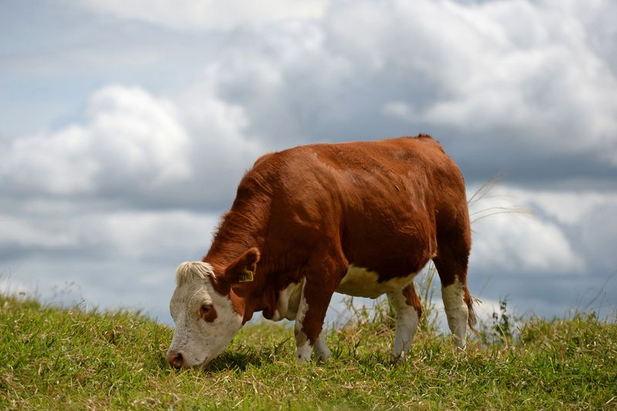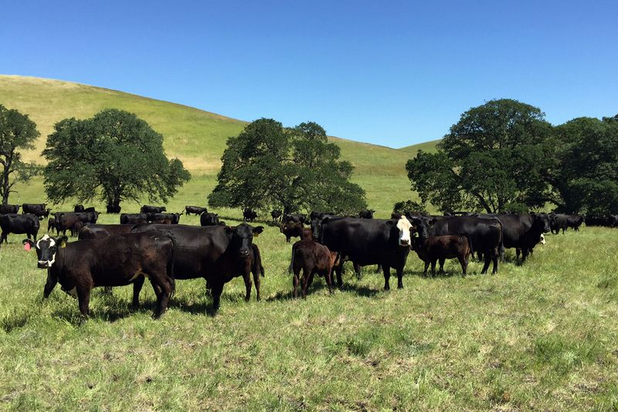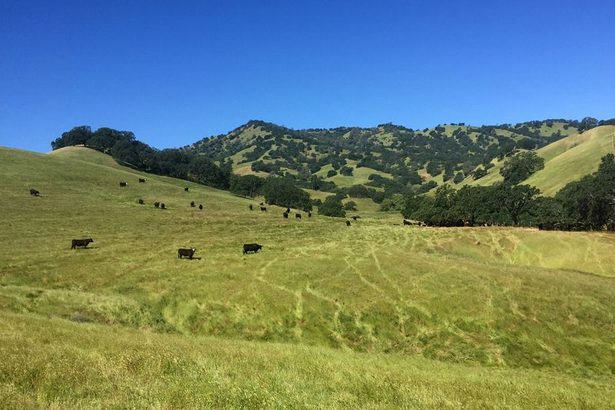Bloomberg: Most Grass-Fed Beef Labeled ‘Product of U.S.A.’ Is Imported
Foreign meat makes up the bulk of an increasingly sought-after product. Perdue Farms is hoping a new acquisition will revive domestic sales.
By Deena Shanker |May 23, 2019
If you’ve eaten grass-fed beef in America over the past few years, chances are the cows weren’t raised in the U.S., even if the package has “Product of U.S.A.” printed on it. Meat giant Perdue Farms said it wants to change that.
As consumers seek out premium animal products, grass-fed beef is riding a wave of popularity, hitting $480 million in supermarket sales for the 52 weeks ending April 20. This represents 15% year-over-year growth, compared with the rest of the sector’s 3% uptick, according to data from Nielsen. Restaurants have also jumped on the bandwagon, with shipments from distributors to independent and small chain restaurants increasing by 15% for the year ending in March, according to an NPD analysis.
Mainstream retailers such as Kroger, Walmart and Safeway carry it, and such casual restaurant chains as Panera and Chipotle made the switch years ago. But as appetites for more naturally raised beef have grown, so have cheaper imports. At the “finishing” phase of a cow’s life, raising grass-fed beef in Australia cost 59 cents for every pound gained, according to an April 2017 report on the market from Stone Barns Center for Food & Agriculture. For a large U.S. grass-fed producer, that cost rises to $1.55 per pound. For a small U.S. producer, it can be as high as $4.26.
Countries with four seasons of sunny, relatively temperate weather have a distinct advantage, since that translates into year-round grass and consistently high-quality beef—something the American grass-fed industry has struggled to produce. Add in the scale of existing livestock operations in countries such as Australia and New Zealand and across South America, and foreign operators can sell their beef at a lower price.

Photographer: Dimas Ardian/Bloomberg
Unsurprisingly, less expensive grass-fed beef from these countries has been rolling into the U.S. for some time. By value, 75% to 80% of grass-fed beef sold in the U.S. comes from abroad, according to the Stone Barns report.
If you’re a U.S. consumer, you could be forgiven for being surprised. That’s because in 2015, the U.S. government repealed short-lived rules mandating “country of origin” labeling. It required non-processed beef and pork that was sold in retail to say where it was born, raised and slaughtered. Under current policy, meat products can come in from other countries and—after being “processed”( which could mean simply cutting a large piece into smaller ones inside a U.S. Department of Agriculture-inspected plant)—receive a “Product of U.S.A.” stamp.
Instantly, cows that spent most of their lives thousands of miles away suddenly become American bovines.
The labeling gets even trickier, since the designation “grass-fed” doesn’t have an official USDA definition. Unlike anything with an organic seal, which requires adherence to more definitive USDA rules, calling beef “grass-fed” doesn’t require an on-farm inspection or even mandate that animals live freely on a pasture. Some “grass-fed” beef comes from cattle raised in grass feedlots, where they are confined in pens and fed grass pellets, according to Stone Barns. Other beef products are labeled “grass-fed, grain-finished,” a shorthand for the standard cattle practice of raising cows on grass for most of their lives and then fattening them up quickly at the end.
Thanks to vague and misleading labels up and down U.S. supermarket aisles, many Americans are already skeptical when they read claims on food packaging. Your mental picture of that magnificent American steer grazing in the shadow of the snow-capped Rocky Mountains? That’s a pickup truck commercial. The reality is that your steak probably came here in a container ship filled with frozen carcasses killed on the other side of the planet.
Now a company is looking to end this disconnect. Perdue—more famous for selling chickens than beef—announced Thursday that it’s building a market for grass-fed beef that’s truly Made in America, even if it costs more than the imported kind. Led by Jeff Tripician, president of Perdue’s premium meat division, the company said it’s acquiring Panorama Meats, America’s largest producer of grass-fed, certified organic beef. The cattle are raised on 1 million acres of USDA-certified organic grasslands in Northern California, Southern Oregon, Montana, South Dakota, Nebraska, Wisconsin and Colorado, Perdue said.

Source: Pete’s Valley Cattle
By joining with Perdue, Panorama will be able to cut distribution and processing costs and avail itself of Perdue’s long list of customers—from James Beard-award-winning chefs to major restaurant chains, including several that currently feature foreign grass-fed products on their menus.
This isn’t Perdue’s first foray into the premium meat market. Tripician came to the chicken giant as part of its 2015 acquisition of Niman Ranch, known for its high-end pork, and also worked at Coleman Natural Foods, which Perdue acquired in 2011.
For Perdue, an increased consumer focus on animal welfare has translated into higher sales. It was the first major chicken producer to get rid of antibiotics, and its organic business is growing fast, making up 1 million of its 13 million birds. Niman recently committed to doubling its farmer network over the next decade, and Coleman’s pork division alone reported a sales jump of more than 270% from 2011 to September 2018, from $30 million to $111 million.
While Perdue will help Panorama lower the cost of producing grass-fed American beef, Tripician said consumers shouldn’t expect lower prices—his grass-fed beef will continue to be a premium product. “We’re not going to squeeze the farmer or rancher,” he said in an interview. “When we see that money, we tend to invest it.”
For Niman Ranch, that extra revenue has translated into benefits such as more veterinarians, field agents and training. The strategy has paid off for the company as well, attracting more younger employees to a job demographic that’s been aging fast. Tripician said the average farmer providing the company with livestock is 18 years younger than the national average.
“With this acquisition, we’re confident that we’re going to be able to ensure long-term stability for our producer network,” said Lori Carrion, Panorama’s chief executive. Panorama counts almost 50 beef producers in its network and hopes to “add more family ranching communities.”
The first step in Perdue’s planned expansion will be to line up additional customers for its expensive grass-fed products. Then Panorama will expand its rancher network. “It will be a slow build, because it takes a long time to raise cattle.”
And this is what presents a problem for some environmentalists. Truly grass-fed cattle take a lot longer to raise than conventional beef, contributing more methane to the atmosphere and thus, they contend, further fueling global warming. Typical American cattle finish a 16- to 20-month life on a feedlot, where they get fattened on corn and other grains and often gets routine doses of antibiotics and synthetic hormones to speed the process. Such 100% organic and grass-fed cattle as Panorama’s don’t get help from grains, antibiotics or added hormones, and thus need 20 months to 28 months to reach market weight.
There are some benefits (beyond better-tasting beef) to letting cattle wander wide swaths of grazing land, said Tim Searchinger, a senior fellow at the World Resources Institute who specializes in food sustainability. Acres of feedlots produce tons of manure in small areas, adding to already massive pollution problems that plague the industry. Grazing cattle, meanwhile, spread their manure over greater areas, protecting soil quality and avoiding runoff. However, this production method can have downsides. Searchinger noted that “grass-fed” in places such as South America can involve clearing tropical forests to create pasture, resulting in the decimation of natural carbon sinks.
Even the impact of well-managed grazing systems is up for debate. On one hand, you have operations such as White Oak Pastures in Bluffton, Georgia, which focus on regenerative agriculture and a range of crops and animals, including grass-fed beef. White Oak is actually removing 3.5 kilograms of carbon dioxide from the atmosphere for every kilogram of beef it produces, according to a life-cycle analysis by Quantis commissioned by General Mills.
However, Searchinger points to a March 2018 study, published in Environmental Research Letters, finding that switching all cattle production to grass-fed in the U.S. would increase methane emissions by approximately 8%.
“At best, you’re probably coming close to matching,” Searchinger said of grass-fed cattle-emissions, compared with those of industrial beef. “Mostly, you’re emitting more.”
But there are broader benefits to grass-fed cattle, Tripician argued. Animal welfare is better, soil health is improved and grains aren’t being transported across the country, lessening the industry’s carbon footprint. Now, with Perdue’s backing, the hope is that market access for American grass-fed beef will expand and that consumers, at least, will know what they’re buying.


A couple missing elements in the discussion regarding the environmental impacts of grass-finished beef vs industrial beef is that herbivores grazing on grass is the only way to turn range land into food that humans can digest whereas the grains fed to cattle in feedlots is otherwise plenty palatable to humans. The landscapes shown in the accompanying photos is better left in grass than plowed for grains whereby it would be subject to erosion and emitting, rather than sequestering, carbon.